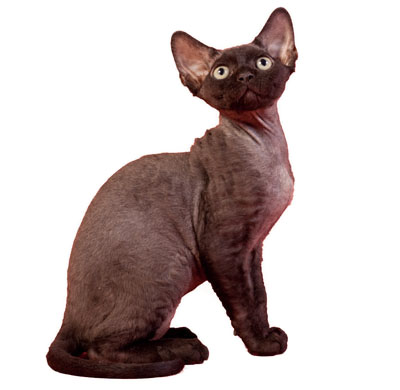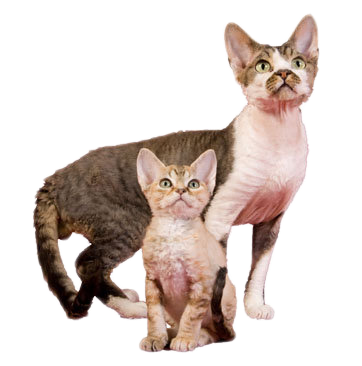Devon rex
Breed description
In Buckfastleigh, Devonshire, England, in 1960, a certain Miss Cox became aware of a curly tom cat living in a deserted tin mine near her home. It therefore came as no surprise to her then when one day a stray tortiseshell female gave birth to a curly-haired kitten. She considered him quite beautiful, with lots of curls and even ringlets on his tail.
For the past ten years, the curly-haired "Rex" breed that was to become today's Cornish Rex had been quite the rage in England, and many English breeders had been eagerly working with these "poodle cats".
Delighted with her kitten, Miss Cox named him "Kirlee".
As Kirlee grew, Miss Cox contacted a Mr. Brian Stirling-Webb, who was working to establish the curly-haired "Rex" (after the curly-haired Rex rabbits) cats as a breed, and offered the use of Kirlee as an outcross, to help increase the size of the Rex gene pool. Mr. Stirling-Webb and the other rex breeders were indeed very excited to hear the news.
They persuaded Miss Cox to send them Kirlee to use with their rex program. Kirlee was mated with several rex females and eagerly awaited the upcoming kittens. To everyone's surprise, the resulting kittens were all straight-haired! After several additional attempts, it was apparent that Kirlee represented a completely separate genetic variation than that found in the other "Rex" cats (who became referred to as "Gene I" Rex, as opposed to Kirlee's "Gene II"). Work proceeded apace to establish both as independent breeds.
The "Gene I" Rex cat became known as the Cornish Rex, due to their origin in Cornwall, England (quite close to Devonshire), and has a curly coat with no guard hairs, and awn hair that is difficult to distinguish from the down. The body type is somewhat reminiscent of the "oriental" breeds of cats (such as Siamese), and the head is comprised of a series of smooth oval shapes.
Kirlee and the "Gene II" Rex cats became known as the Devon Rex, and established a look and breed characteristics distinctly their own. The Devon's coat contains all three types of hairs, although somewhat modified, and has a larger and looser curl than the Cornish Rex. The body type is very different as well, stockier and more heavily built, with a broader and shorter head with lower ears, and the distinctive "pixie" or "elfin" that has come to be the hallmark of the Devon look.
In 1967, Great Britain's Governing Council of the Cat Fancy (GCCF) recognized the distinction between the two breeds, and wrote standards to allow each of them into competition as distinctive breeds of cat.
The Devons became very popular among many who were attracted to not only their unique appearance, but their distinctive personalities as well. The first Devon Rex were imported into the United States by Marion White of Austin, Texas in 1968, and had been bred by Mrs. Ashford. Since the late 1960s, breeders in many countries have been active in working with the Devon Rex, including those from many European countries, as well as New Zealand and Australia. The United State's largest cat registry, the Cat Fancier's Association (CFA) recognized the Devon Rex as a breed eligible for championship competition in 1979.
Although one of the cat fancy's youngest breeds, the Devon Rex has made great inroads in stealing the hearts of many cat lovers worldwide.
FIFe Devon Rex standard


